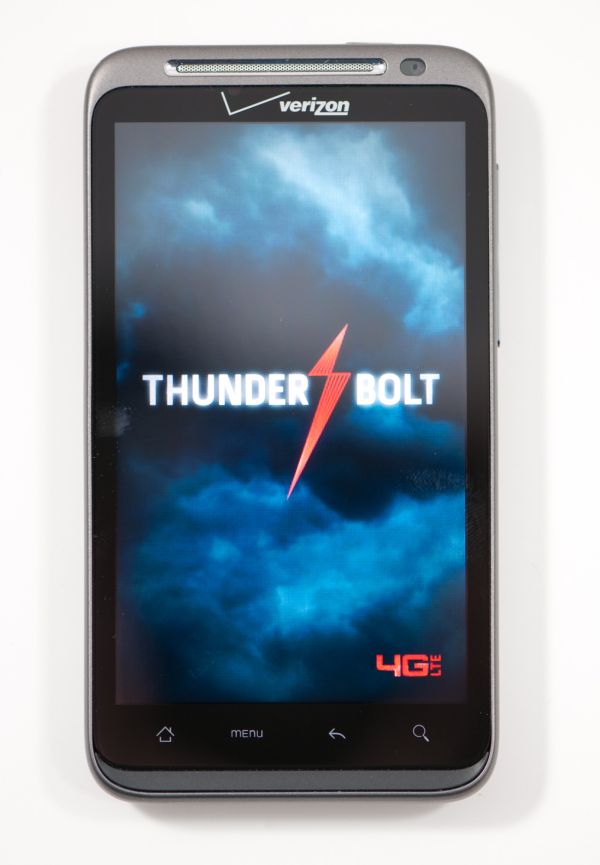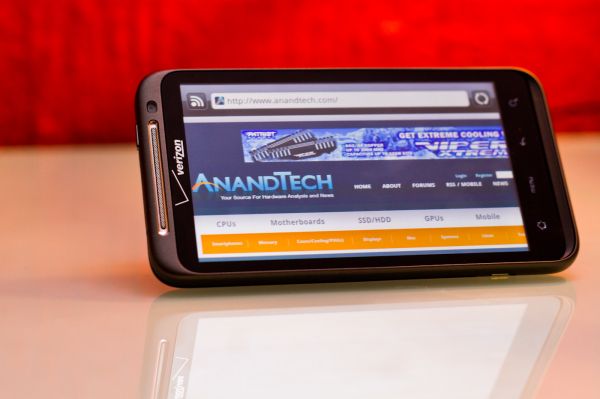HTC Thunderbolt Review: The First Verizon 4G LTE Smartphone
by Brian Klug on April 27, 2011 12:12 AM EST- Posted in
- Smartphones
- HTC
- Verizon
- LTE
- 4G
- Android
- HTC Thunderbolt
- Mobile
- MDM9600
- MSM8655
Conclusion
The Thunderbolt reminds me of the EVO, and otherwise shares design language with all of HTC’s 4.3” form factor smartphones. The comparisons are so completely obvious that it’s almost pointless stating all of them. It’s a phone packed with latest and greatest cellular connectivity that actually does a very good job at disguising the number of design challenges doing so poses. LTE is easily an order of magnitude faster than EVDO, and if you're as obsessed with cellular network throughput as I am, the added thickness and reduced battery life are absolutely worth it.
I’ve talked a lot about thickness and weight, but at the end of the day the Thunderbolt is entirely pocketable and feels great in the hand. Despite not being metal and unibody like the Desire HD, the phone feels sturdy and build quality isn’t going to disappoint. It’s almost unfair to make size and weight comparisons against devices that are primarily built around one transceiver and a SoC.
That said, there’s no getting around issues such as battery life and the fact that though the Thunderbolt is the current latest and greatest, it still lacks dual core and a qHD screen. Those two features are going to be must-have in the next set of refreshes from HTC, and as a result makes the Thunderbolt almost feel a bit delayed. Battery life can be doubled by using the double capacity official battery, but again at the expense of adding more mass and thickness to an already beefy handset.

The HTC Thunderbolt in front of a Verizon 4G LTE eNodeB
The Thunderbolt’s cellular architecture is impressive, and its status as the first smartphone on Verizon (or CDMA2000 to the best of my knowledge) that can offer simultaneous voice and data in both 3G and 4G network conditions is a huge plus even if you aren’t in a 4G LTE market. It’s very surprising to me that Verizon has neglected to pick up on and aggressively market that selling point, considering AT&T's repeated jabbing. It’s a special extra that will likely continue to distinguish the Thunderbolt from a growing lineup of 4G LTE enabled smartphones set to arrive on Verizon this year. It's likewise surprising that the Thunderbolt isn't a "Droid" level phone, and considering the amount of unique things the Thunderbolt brings to the table, the other 4G LTE smartphones will have their work cut out for them stacking up. 4G LTE works perfectly on the handset, and is fast enough that I believe we’re back to page loading being SoC-bound rather than network-bound.












71 Comments
View All Comments
kmmatney - Wednesday, April 27, 2011 - link
One important battery test is how long the phone lasts just sitting around doing nothing, or walking around in a pocket. I can get 3 days out of iPhone 3GS, if I just use it as a phone and not much else.hans007 - Wednesday, April 27, 2011 - link
this or the charge are both pretty similar.the bionic is delayred until at least Q3 . i'm figuring there is probably a reason there are no dual core LTE phones out and they keep getting delayed.
i think either of them is a good choice, if you want to mod your phone, the tbolt is already rooted with several custom roms, and CM7 is already in alpha/beta stage.
HangFire - Wednesday, April 27, 2011 - link
Brian,It's not the BB app but the background services behind it that are persistent, particularly PVWmdrmService. You can kill it but it will come back on next reboot.
The first hit on a Google of Thunderbolt Disable Blockbuster recommends starting and updating the app, and then turning off updates from within the app. While this seems to be good advice as far as data usage goes, it does nothing for preventing the background services from starting and taking up RAM.
Looking forward to what you find on the 8GB issue.
bplewis24 - Wednesday, April 27, 2011 - link
Brian, excellent job with the review. One of my favorite aspects of the review is how you appropriately compared it to different devices in different contexts (design, function, performance, display, etc), instead of always comparing it to the iPhone4 or always comparing it to the Evo, etc.Very objective, informative and practical review, which I realize is a delicate balance.
Kudos,
Brandon
HangFire - Wednesday, April 27, 2011 - link
Just a note, I work in a non-LTE area of MD, and 3G (HRPD I suppose) has been working great all day.pedant - Wednesday, April 27, 2011 - link
"That’s almost exactly double the size"...vision33r - Wednesday, April 27, 2011 - link
Soon, all these Android phones will be 4.5"+ and pushing towards 4.7" and 5.0"synaesthetic - Thursday, April 28, 2011 - link
The 4" screen size with the near-8:5 aspect ratio is absolutely my sweet spot. Software problems aside, I love love LOVED my Galaxy S's screen size. The slightly smaller one on my Glacier just feels a bit cramped.carte247 - Wednesday, April 27, 2011 - link
Good job Brian on the extremely thorough and interesting review. There's always a level of thought and analysis in Anandtech reviews that other sites lack. Or maybe I should be angry, as you're seriously making me consider moving away from my G2 (which up until now I was perfectly happy with...).mlangsottile - Thursday, April 28, 2011 - link
Absolutely fantastic review. Anand Tech is my favorite source for detailed technical analysis of consumer electronics like this. Keep up the good work.